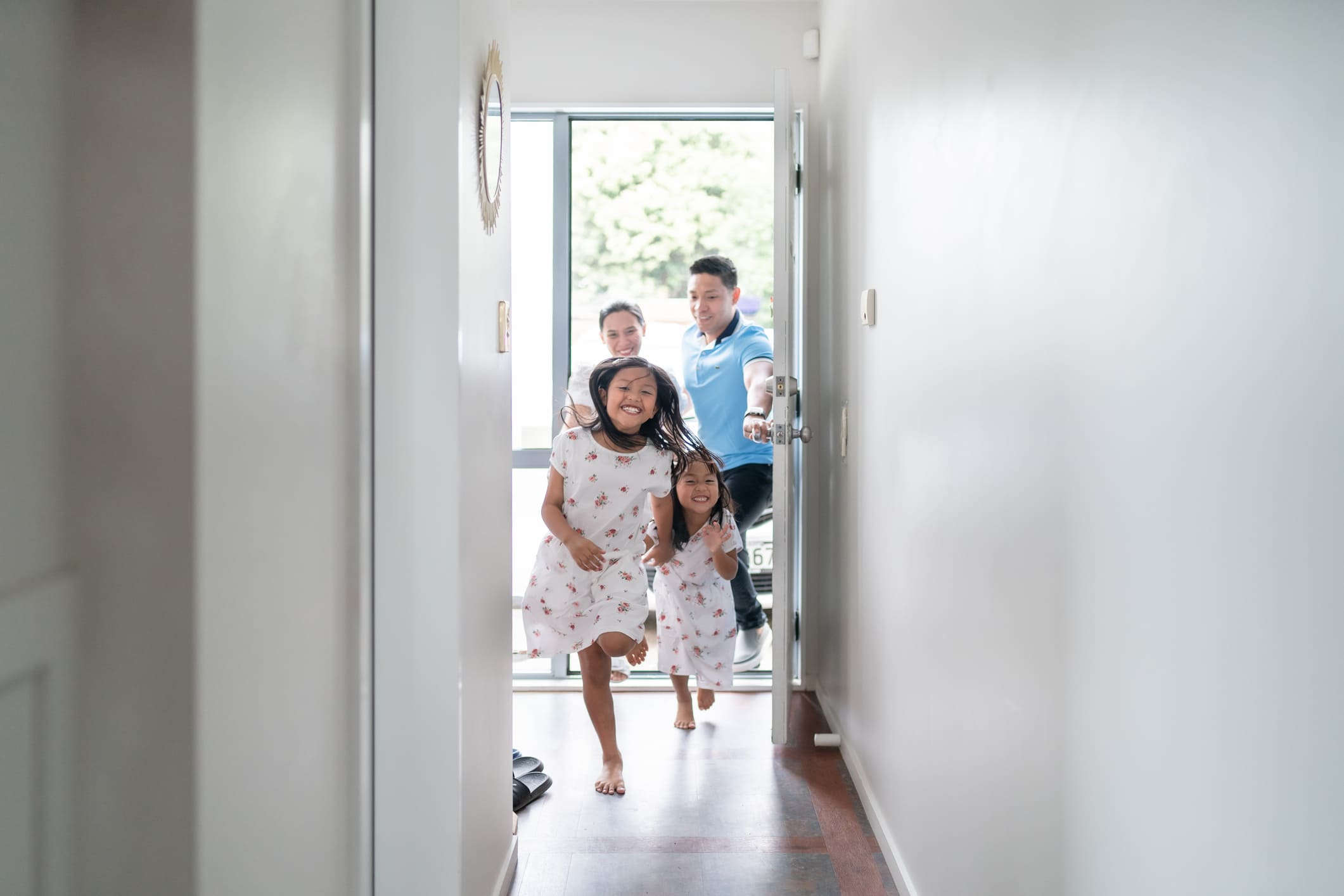
Moving to a new home can be an exhilarating yet daunting experience for any family. Amidst the chaos of packing boxes, coordinating logistics, and bidding farewell to the familiar, it's crucial to recognise the unique impact such a transition can have on our little ones. Children, in particular, navigate a rollercoaster of emotions during a move – from the thrill of embarking on a new adventure to the trepidation of stepping into the unknown, and the melancholy of parting ways with places they've grown accustomed to calling home.
As parents, we must guide our children through this intricate journey with sensitivity and understanding. By proactively engaging them in the process and finding ways employing strategies to alleviate their anxieties, we can transform what might seem like an overwhelming ordeal into a memorable and enriching experience for the entire family.
This guide will delve into tips and insights to help parents navigate the complexities of relocating with children. From fostering a sense of excitement about the upcoming changes to providing the necessary support to cope with the inevitable challenges, let's embark on this journey together, ensuring a smooth transition for our little ones and nurturing their resilience every step of the way.
Moving with kids transcends the physical act of packing boxes and changing addresses. It's a deeply personal journey that can significantly impact their emotions and sense of stability. Recognising this impact is crucial, allowing us to navigate the process with empathy and understanding. While every child experiences the transition uniquely, here are some common emotions they might encounter:
Excitement:
Younger children, in particular, may view the move as an exciting adventure brimming with new possibilities. They might be eager to explore a new house, neighbourhood, and potentially even a new school, viewing it as an opportunity for fresh experiences and friendships.
Fear:
Leaving behind familiar faces and places can be a daunting experience for children. This can ignite fears of the unknown, including anxiety about making new friends, adjusting to a different environment, and navigating unfamiliar routines. These fears are particularly prevalent in older children who may have established strong bonds with their surroundings and social circles.
Sadness:
Saying goodbye to the familiar can be a source of sadness for children. They might experience a sense of loss and nostalgia as they bid farewell to their old home, cherished memories, and established routines. This sadness can manifest in different ways, like withdrawal, clinginess, or even outbursts of emotion.
It's important to remember that these emotions are all valid and deserve acknowledgement. By understanding how children might be feeling, we can better support them through the transition and help them navigate the challenges and opportunities that a move presents.
Empowering children by involving them in the moving process is a win-win situation. It not only fosters a sense of ownership and control but also helps lessen anxieties about the unknown. Here are some age-appropriate ways to engage them:
1. Packing
Matching Skills:
Younger children can help with tasks like sorting socks or placing books in boxes, while older ones can handle more complex activities like labelling boxes with categories or writing their names on their designated packing containers.
Collaborative Packing:
Turn packing into a family affair. Assign different boxes or categories to each family member and work together to pack them efficiently. This not only involves kids but also fosters a sense of teamwork and eases the workload.
Themed Packing Days:
Declare a "Toy Day" or "Dress-up Day" where kids pack their belongings in those categories, adding a fun element to the process.
2. Decorating Boxes
Let their creativity roam free:
Provide them with markers, paints, stickers, and other crafting materials to personalise their boxes with drawings, pictures, or even short messages expressing their feelings about the new adventure.
Theme the decorations:
If they are moving to a beach town, they could decorate their boxes with seashells or drawings of the ocean. This personalises the packing process and helps them visualise their new environment.
3. Planning their New Room
Empower decision-making:
Give them choices for their new room, such as choosing paint colours from a pre-selected palette or selecting furniture arrangements from different layouts. This empowers them to feel invested in their new space.
Create a "New Room Vision Board":
Help them gather pictures from magazines or online of furniture styles, colour schemes, or decorative elements they like. This allows them to express their desired aesthetics and collaborate with you on creating their ideal room.
4. Transforming Tasks into Fun Activities
"Treasure Hunt" Packing:
Hide a small note or favourite toy in their box and let them search for it after packing. This adds an element of surprise and excitement.
"Memory Boxes":
Designate special boxes for them to gather keepsakes and mementos from their old home, like photos, artwork, or small trinkets. This provides a sense of continuity and allows them to cherish their memories while embracing the future.
Remember, the key is to tailor these activities to their age and interests. By involving them in the process, you can transform a potentially stressful experience into a positive one, fostering excitement and easing the transition to their new home.
Saying goodbye to the familiar can be a challenging, yet important, aspect of the moving process. However, by creating opportunities for closure, we can help children process their emotions and create lasting memories. Here are some creative ideas to encourage a meaningful and positive farewell:
1. Memory-Making Activities
Create a "Farewell Tour":
Take a walk around the neighbourhood, visiting favourite spots and reminiscing about special moments. Capture pictures and videos to document this sentimental journey.
Time Capsule Creation:
Gather small items that represent their life in the old home, like drawings, toys, or notes to their future selves. Seal them in a decorated box to be opened at a designated time in the future.
Write "Goodbye Letters":
Encourage them to write letters to their old home, thanking it for the memories and expressing their feelings about leaving. These letters can be buried in the backyard or kept as a cherished keepsake.
2. Commemorative Celebrations
Organise a "Going-Away Party":
Invite close friends and neighbours to celebrate their time in the old home. Encourage the sharing of stories, photos, and laughter while fostering a sense of community and shared memories.
Plant a "Farewell Tree":
Plant a tree in the yard as a symbol of growth and new beginnings, while also leaving a lasting reminder of their time in the old home.
Create a "Memory Wall":
Dedicate a space in their new home to display photos, artwork, or memorabilia from the old home. This helps them retain a sense of connection to their past while embracing the future.
While saying goodbye is essential, building anticipation for the new adventure can lessen anxieties and increase excitement. Here's how:
1. Virtual Exploration
Take a "Virtual Tour":
Utilise online resources like Google Maps Street View to explore their new neighbourhood virtually. Point out landmarks, parks, and potential places of interest to pique their curiosity.
"New Home Scavenger Hunt":
Search online for pictures of their new neighbourhood, focusing on specific buildings, landmarks, or parks. Create a scavenger hunt list and have them "virtually" locate these features, fostering a sense of familiarity and anticipation.
2. Planning and Personalisation:
"New Room Design Challenge":
Provide magazines, online resources, or design tools and let them create their dream room layouts and decorations. This empowers them to take ownership and personalise their space.
"Welcome Home Signs":
Work together to create personalised welcome signs for the front door or their new room. This small act can personalise their arrival and mark the beginning of a new chapter.
3. Maintaining Routines
Amidst the changes, maintaining familiar routines like mealtimes, bedtimes, and family activities can provide stability and comfort for children during the transition. This consistency helps them feel grounded and secure despite the relocation.
By incorporating these suggestions, you can help your children navigate the complexities of saying goodbye to their old home while building excitement and a sense of ownership in their new space. Remember, open communication and acknowledging their emotions are crucial throughout the process.
The first few days in a new home can be a whirlwind of emotions for children. Here are some ways to help them feel comfortable and create positive memories:
1. Foster Familiarity and Fun
Family Movie Night:
Cozy up together for a movie night in the new living room. This familiar activity provides a sense of comfort and normalcy amidst the changes.
Treasure Hunt:
Organise a scavenger hunt throughout the house with small treats or clues hidden in different locations. This encourages exploration and helps them familiarise themselves with the new space in a fun and engaging way.
"New Home Olympics":
Organise playful competitions around unpacking, decorating, or exploring the backyard. This adds a lighthearted element and brings the family together as they navigate the new environment.
2. Cultivate Open Communication
Create a Safe Space:
Make it clear that you are available to listen and talk about their feelings about the move, the new home, and anything else on their minds.
Active Listening:
Pay close attention to their verbal and non-verbal cues – their silence, expressions, and behaviour can often communicate unspoken emotions.
Validate their Emotions:
Acknowledge and validate their feelings, whether they are excited, scared, sad, or confused. Let them know it's okay to feel this way and that you are there to support them.
Helping children thrive in their new environment takes time and a supportive network. Here are some ways to facilitate their long-term adjustment:
1. Encourage Social Interaction
Enrol them in local activities:
Look for opportunities for them to connect with other children through sports teams, dance classes, or community events. These activities not only promote social interaction but also help them discover new interests and build self-confidence.
Connect with other families:
Reach out to families in the neighbourhood or through online communities. Arrange playdates, participate in neighbourhood gatherings, or even join a local parent group. This fosters social connections for both children and parents, creating a sense of belonging in the new community.
2. Patience and Support
Be patient:
Remember, adjusting to a new environment takes time. Be patient with your children and offer support throughout the transition.
Celebrate small wins:
Celebrate their achievements, big or small, to boost their confidence and encourage them to embrace their new surroundings.
By implementing these suggestions, you can help your children transform the new house into a home, filled with happy memories and a sense of belonging.
Building a Foundation for Growth: Moving with Confidence and Creating Lasting Memories
Moving with kids is a transformative journey, offering both challenges and opportunities for growth. By prioritising understanding, support, and active involvement, we can turn this event into a positive chapter for our children, fostering resilience and adaptability.
Partnering with a professional moving company like Aussiemove can streamline the process, alleviating much stress for families. Its expertise in packing and logistics allows parents to focus on nurturing their children through the emotional aspects of the transition. This partnership also ensures peace of mind, knowing belongings are in safe hands.
By combining Aussiemove's support with your involvement, you can create a positive and memorable moving experience for everyone in the family. This lays the foundation for growth and resilience in our children, allowing them to embrace the exciting possibilities in their new home.
Get a Quick Quote!
Would you like to know more? Fill out the form below and we will be in touch to help answer all your moving questions.






